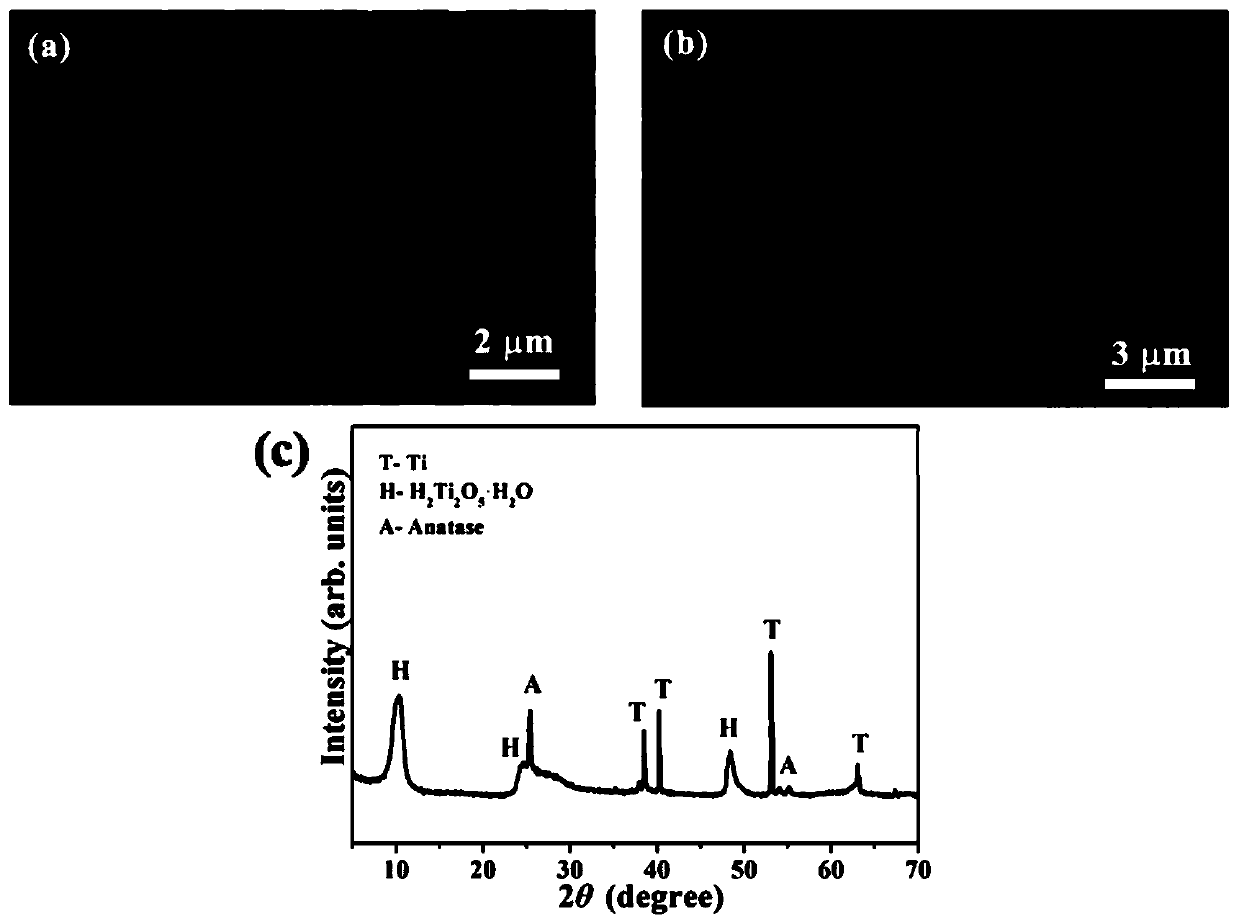In-situ preparation method of titanium dioxide-based metal oxide composite nano-catalyst material
A nano-catalyst, titanium dioxide technology, applied in the field of in-situ preparation of titanium dioxide-based metal oxide composite nano-catalyst materials, to achieve the effect of low cost and simple process
- Summary
- Abstract
- Description
- Claims
- Application Information
AI Technical Summary
Problems solved by technology
Method used
Image
Examples
Embodiment 1
[0084] This embodiment is the in-situ growth of titanate or titanium dioxide nanosheets on the surface of the Ti mesh metal substrate, as follows:
[0085] 1. Add 1L deionized water to the beaker, and add 10g Na 3 PO 4 12H 2 O, after mixing evenly, an electrolyte solution for liquid-phase plasma discharge is obtained.
[0086] 2. Using industrial pure titanium (Gr1) as the substrate, firstly cut the titanium mesh into a suitable size, and then pretreat it. Put the Ti net into acetone and ultrasonically 15min to remove the oil on the surface, then rinse the remaining acetone with deionized water, then put the Ti net into water at room temperature: nitric acid: hydrofluoric acid = 5:4:1 (volume than) treatment for 60s to remove the oxide layer on the surface, and finally washed with deionized water and absolute ethanol.
[0087] 3. Put the electrolyte obtained in step 1 into a stainless steel electrolytic cell, then use the pretreated Ti mesh as an anode electrode, and the s...
Embodiment 2
[0093] This embodiment is a transition metal oxide co-catalyst nanomaterial modified on the surface of titanium dioxide nanosheets, specifically as follows:
[0094] 1. Add 1L deionized water to the beaker, and add 10g Na 3 PO 4 12H 2 O, after mixing evenly, the electrolyte solution for liquid-phase plasma discharge is obtained.
[0095] 2. Using industrial pure titanium (Gr1) as the substrate, firstly cut the titanium mesh into a suitable size, and then pretreat it. Put the Ti net into acetone and ultrasonically 15min to remove the oil on the surface, then rinse the remaining acetone with deionized water, then put the Ti net into water at room temperature: nitric acid: hydrofluoric acid = 5:4:1 (volume than) treatment for 60s to remove the oxide layer on the surface, and finally washed with deionized water and absolute ethanol.
[0096] 3. Put the electrolyte obtained in step 1 into a stainless steel electrolytic cell, then use the pretreated Ti mesh as an anode electrode...
Embodiment 3
[0102] This embodiment is a transition metal oxide modified on the surface of titanium dioxide nanosheets, specifically as follows:
[0103] 1. Add 1L deionized water to the beaker, and add 10g Na 3 PO 4 12H 2 O, after mixing evenly, the electrolyte solution for liquid-phase plasma discharge is obtained.
[0104] 2. Using industrial pure titanium (Gr1) as the substrate, firstly cut the titanium mesh into a suitable size, and then pretreat it. Put the Ti net into acetone and ultrasonically 15min to remove the oil on the surface, then rinse the remaining acetone with deionized water, then put the Ti net into water at room temperature: nitric acid: hydrofluoric acid = 5:4:1 (volume than) treatment for 60s to remove the oxide layer on the surface, and finally washed with deionized water and absolute ethanol.
[0105] 3. Put the electrolyte obtained in step 1 into a stainless steel electrolytic cell, then use the pretreated Ti mesh as an anode electrode, and the stainless steel...
PUM
| Property | Measurement | Unit |
|---|---|---|
| current density | aaaaa | aaaaa |
| thickness | aaaaa | aaaaa |
| thickness | aaaaa | aaaaa |
Abstract
Description
Claims
Application Information
 Login to View More
Login to View More - R&D
- Intellectual Property
- Life Sciences
- Materials
- Tech Scout
- Unparalleled Data Quality
- Higher Quality Content
- 60% Fewer Hallucinations
Browse by: Latest US Patents, China's latest patents, Technical Efficacy Thesaurus, Application Domain, Technology Topic, Popular Technical Reports.
© 2025 PatSnap. All rights reserved.Legal|Privacy policy|Modern Slavery Act Transparency Statement|Sitemap|About US| Contact US: help@patsnap.com



